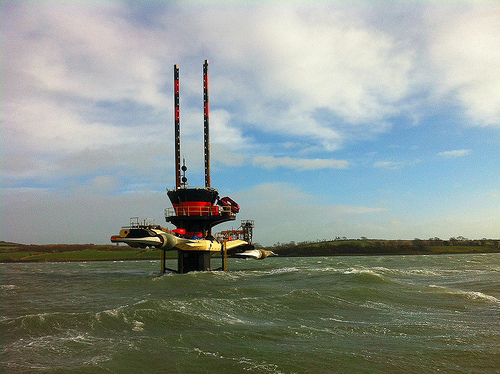The SeaGen project is a tidal energy project located in Strangford Lough, Northern Ireland and developed jointly by the UK Government and private investors. The unique design and location of the SeaGen project allows capture of the maximum amount of tidal energy whilst keeping maintenance and connectivity costs low. Strangford Lough has one of the best tidal resources in the world. Its relatively sheltered environment and its easy access make it ideal as a demonstration site for tidal energy.

Strangford Lough tidal device. The image shows the rotors out of the water for inspection. Picture from DECCgovuk (Flickr) (CC BY-ND 2.0)
The SeaGen project consists of a device producing 1.2MW power being the world’s first grid connected commercial-scale tidal device and therefore leading the way in tidal current technology. The plant generates 1.2 MW for between 18 and 20 hours a day when the tides are forced in and out of Strangford Loughthrough the Narrows (potential capacity factor of between 75% and 83%, potential annual production of between 7.88 and 8.76 GWh per year). This is the first large-scale tidal power station to build using tidal stream MHK turbine technology.
The installation was completed in June 2008 and SeaGen S project started generating electricity in July 2008. In December 2008 SeaGen S project operated at full capacity for the first time. The project was awarded a five-year licence by the Northern Ireland government, but their success in the recent times has led to a licence extension until 2018.
Strangford Lough is an environmentally sensitive area. During the design phase, a three-year environmental impact study (Environment Monitoring Programme -EMP-) has been made, concluding that no significant impacts that could be attributed to the project had been detected, so finally an environmental all-clear has been given by a group of scientists.
The UK Government funded 50% of the SeaGen project, the other 50% came from private investors keen to be involved and develop tidal energy technology. The final cost of this project has been published, but as an indicative, at present it costs £3M for every MW generated to install marine turbines, compared to £2.3M per MW for offshore wind. However inevitably the costs will drop rapidly if the technology is replicated on large-scale.